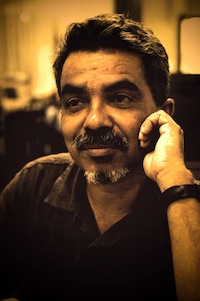Subscribe to ShahidulNews
By Prasanna Ratnayake
Missing for over 300 days
Source: Groundviews
On 25th November, far away from my motherland, I rang Sandya Eknaligoda to ask her, How are you? Yesterday was the 300th day that her loving husband has been missing. And for all Sri Lankans, one of our best cartoonists, writers, journalists, painters and activists has been missing for 300 days.
Sandya told me that a group of about 60 people met yesterday at the Temple of the Innocents with lotus flowers and oil lamps to do a simple ritual for Prageeth. This little monument in front of the Parliament was commissioned by Chandrika Kumaranathunga Bandaranayake?s government, designed and built by the artist, Jagath Weerasinghe, to remember victims of the late 80s/early 90s Southern insurgency. It had been long neglected, its meaning forgotten. Soldiers, whose job is to protect the coming and going Parliamentarians, had been using it as a place to piss. But friends cleaned it up and made it the place to be together on Prageeth?s 300th day.

My mind has been scrolling through the decades during which Prageeth and I have known each other. These are a few of those moments with my missing friend:
In the years of 60,000 dead, the late 80s and early 90s, Mawatha (The Way) magazine was struggling to make sense of our country?s vortex of insanity. Bahktin, Bukharin, Gramsci, Althusser, Foucault, Derrida, all were being studied as fuel for our political thinking, trawled for a social analysis that might help us understand. It was 1990 and I had cycled into town, Galle in the south of Sri Lanka, to buy vegetables for my Auntie. I secretly bought a copy of Mawatha, rolled it carefully into the Government newspaper and hid it beneath the vegetables in the bottom of my basket because there were checkpoints every 500-1000 meters. Back at Auntie?s, I found a private place to read. This is where I first met Prageeth, in his writings for Mawatha 20 years ago.
The next time was in person in 1992 in Colombo. A group of us, young and middle class, used to meet to discuss politics, culture, democracy, human rights ? everything ? how to make things better, practical steps, what to do about our disastrous country. Prageeth was always present, mostly silent, closely observing.
Later, in 1992-4 we had a movement we called Freedom from Fear, confronting the cycles of violence in our world, against the killings and disappearances, trying to create a properly democratic space. Prageeth drew two portraits that became iconic images. One was of Richard de Zoyza, the popular actor, journalist and TV presenter whose slaughtered body had been found on a beach south of Colombo. Looking pensive, chin resting on his hand, his face, beard, and glasses aligned, Richard?s gaze was focused on the viewer. The other portrait was of Ranjini Thiranagama, the Tamil academic and human rights activist, founder member of the UTHRJ (University Teachers? Human Rights Organisation Jaffna), who had been killed by the Liberation Tigers of Tamil Eelam (LTTE). These pictures became the emblems of our group.
My fourth moment was working together later in the 90s on the Values of Dissent publications for the Civil Rights Movement. Prageeth was designing the covers and layout, creating the visual concept for the series of books we produced.
In 2007, while abroad, I was reading Prageeth?s pieces on the LankaeNews website; sharp insightful writings about the fundamental issues behind the Mahinda Rajapaksa regime, revealing the deeper meanings, the subtexts and hidden agendas.
Later in 2007, the last time we met in person, we talked a lot about education, the future of the next generation, his kids, and the daughter of a friend. As we said goodbye, Prageeth warned that we have to be very careful. ?These people know how to play the game with the world. They themselves were once democratic and human rights activists ? this regime is full of them!?
Now he is abducted, disappeared, missing for 300 days.
There was a first time: a year ago he was abducted and then released because they ?got the wrong person?. This second time they have dragged him into the vortex of Sri Lanka?s nightmare.
I am looking at the photograph of this little 300 Days ceremony. What can I read in it? I see many people with whom I have been involved the whole of my lifetime; people who fight for equal rights, for human rights, against abuses, war and corruption. There are small differences: people have got a bit old, there are fewer of them; many have been killed, exiled or silenced. But those in the photo, their eyes and faces are so bright, strong and energetic. They look like they have the inner strength and energy to fight for even more decades.
Beyond this photograph of people gathered for Prageeth at the Temple of the Innocents, I see in my mind the Sri Lankan Parliament so nearby. Most of the Parliamentarians sitting there, Ruling Party and Opposition, are responsible as perpetrators, colluders, collaborators and beneficiaries of the violence, the arrests, the abductions, disappearances, tortures, wars, corruption and impunity that has cursed post-independence Sri Lanka.
In one of his poems about Hitler?s Germany, Berthold Brecht asked: If you cannot protect your people, why should the sun rise on your country? In Sri Lanka people from all communities are being abducted, disappeared, tortured and killed. It pains me to say that my friend Prageeth is one amongst tens of thousands. There is a famous poem of Martin Niemoeller about those who dared not speak out when others were being taken. In Sri Lanka, whether you speak or not, whether you act or not, they will come for you.
[For a related article on Prageeth, read ?for The Missing by Gypsy Bohemia]
Related articles: “Crossfire”
